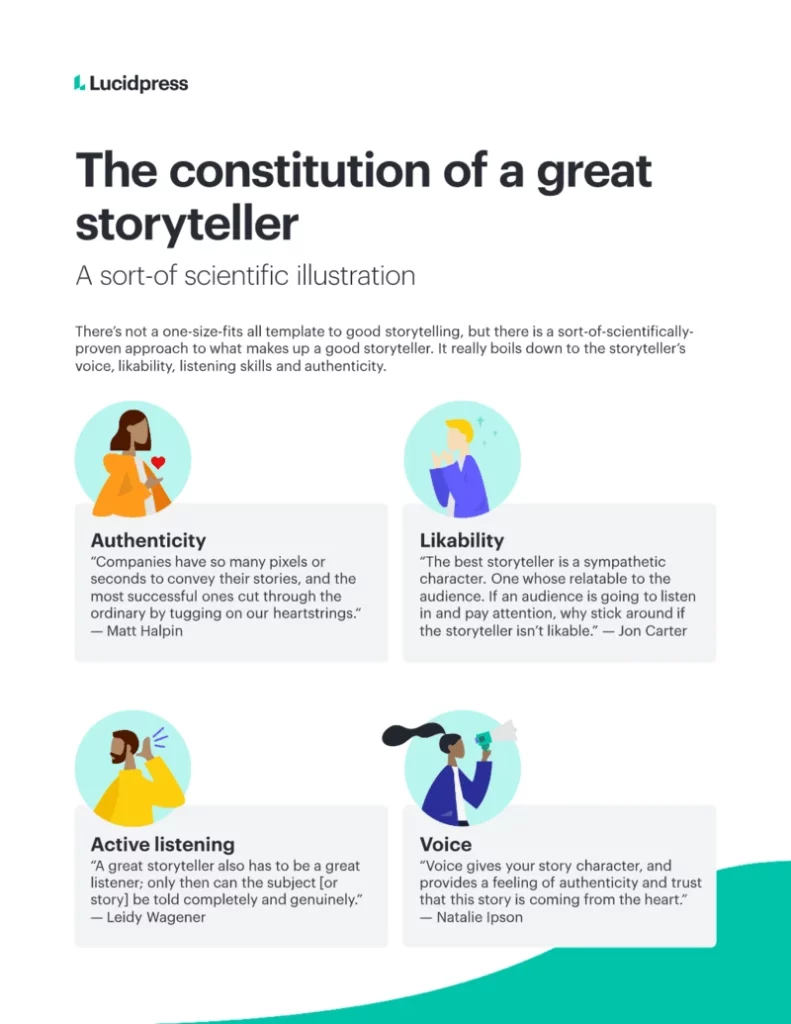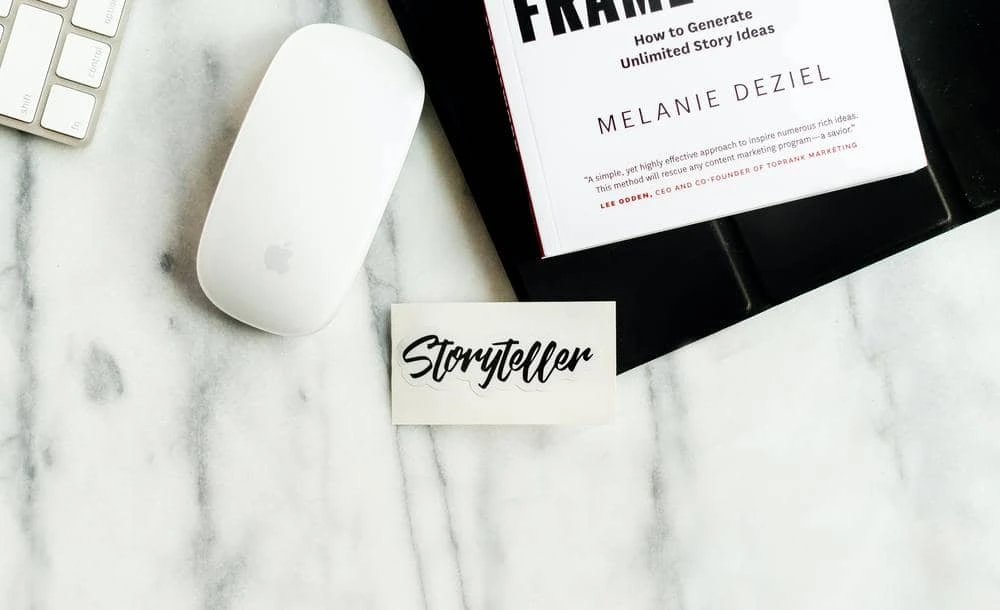The best storytellers know that a good story is more than telling romanticized tales about a life lived. Good storytelling knits together polarity — people, spaces, emotions, conflict and impact — and transforms it into something visible and tangible. While there is a time and a space for waxing poetic, truly compelling storytelling is defined by authenticity and the sum of many parts.
Furthermore, let’s be honest: Try as we might, we can’t all be like Walt Disney. Sometimes we simply can’t feign magic when it’s not there, or perhaps the nature of our work prevents it. Alternatively, we have to practice active listening and cobble together stories from there — because your audience is people too.
To help dispel the myth that we can or must all be like Walt Disney (someday when we grow up), we reached out to the best storytellers we know and asked them to tell us their secret storytelling recipe. Naturally, they delivered.
So without further ado, we’re bringing the TLDR, best-of-the-best storytelling tips to you, so hopefully, you can take something from them and apply it to your stories.
Storytellers featured in this article
- Hanna Reichel — Outdoor industry Brand Strategist, Vermont based
- Jon Carter — Campaign Director for Utah Rivers Council
- Leidy Wagener — Corporate and Foundation Relations Manager at Montana Food Bank Network
- Matt Halpin — Copywriter at Black Rifle Coffee Company
- Natalie Ipson — Media Relations Manager with BYU
How to create compelling stories
Some stories come to life quicker or easier than others. However, regardless of the speed with which you create stories, our blog post participants recommended the following initial tips to nurture an evocative storytelling experience:
Nurture a human connection
“We look for the human element in every piece. Every person has different experiences, but we can connect so quickly through shared emotions. Heartache, love, failure and triumph all feel the same regardless of the circumstances that cause those feelings.”
Natalie Ipson
Remember to center the storyteller’s voice, not your own
“I think that good storytelling from a nonprofit, or even journalistic, standpoint has to be unselfish. When crafting a client story, you are merely a conduit to someone’s story, giving them a voice and platform to be heard. When presenting an organization’s story, you are offering someone an opportunity to support something they are passionate about and believe in. While it certainly doesn’t hurt if you are also passionate about and believe in that work, YOU as an individual aren’t a part of that relationship except as a conveyor of information.”
Leidy Wagener
Leverage technicalities and data when it works
“Everything I write comes back to two questions: How can I most effectively resonate with our customers, and how can I best embody our company mission? We can track the former through analytics. We use all the fancy metrics like click-through rate, ROAS for paid media and so forth. On a technical level, I know what keywords tend to convert better than others when describing our coffee, or which value propositions to use when targeting a higher funnel audience. And I know which CTAs will lead to the most sales. It’s mad science.”
Matt Halpin
Validate passion through messaging
“Especially on the product side, we normally come to stories with a lot of passion, and I do believe that this is an important component of the story: We care. It’s our legacy. Our innovations show that. But passion needs to be validated through straightforward messaging (there’s room for clever, too); it’s easy to forget that not everyone lives and breathes this stuff. I’ve found that one of the most effective ways to demonstrate this is by articulating Problem — Solved.”
Hanna Reichel
The storytelling production process
Jumpstarting the storytelling process can be trying, but our storytellers brought to life their go-to approaches to the storytelling production process without fail. We’ve inverted these suggestions to be reflected as questions for you, the reader, to leverage as an internal checklist as you create stories yourself.
Do I know my audience?
“Every piece of content I create starts with first understanding who my audience is and what that audience needs and wants from me. It’s Communication 101 (so basic!), but so many of us often skip right past that step.”
Natalie Ipson
Do I understand my audience’s triggers or stressors? What can I share that relieves that stress?
People consume content because they want to obtain something. This “something” can be educational, informative, or offer reinforcement for what they already know. Understanding the so-called turning point that pushed your audience into the content consumption phase of their experience is critical. In other words, good storytellers comprehend people’s stressors or triggers, and these folks know how to share information that offers relief or a solution.
What does my audience care about, and am I connected with that passion?
Intersectionality is a critical concept when exploring what your audience cares about and is passionate about. Because for every general group of people, there will be smaller subsets of audiences who experience impact differently. By knowing what your audience cares about (or is impacted by), you can create stories that reflect that passion. Be wary of falling victim to disingenuous gestures or stories — i.e., avoid performative activism, allyship, or storytelling to get content out there.
What is the medium or format I’ll be telling the story from?
“The format in which a story’s told is critical to how you structure your story. A 30-minute speech means you might have a 5-minute intro, 15 minutes for the core content, 5 minutes for a conclusion, and 5 minutes for Q&A. Suppose you are writing a letter to the editor for a newspaper. In that case, you may only have 300 words to tell a story, meaning you are likely limited to focus on just one theme, for a general audience, who you are trying to sway with emotion rather than facts. Facts require lengthy data points. Emotive content requires relatable and experiential content.”
Jon Carter
Do I have a conscious audience, and does my audience care about the story? Why or why not?
“I got the chance to participate in a brand overhaul — we realized that on top of needing a new look and feel, we had to build a conscious audience. We didn’t lack a following, but it wasn’t cohesive or aligned along a particular plotline. This [the overhaul] was cathartic: it was almost as if the audience motivated us to build the product — and the story resonated with our heritage and our audience’s ethos. They inspired us as much as we inspired them. I think being open to what the audience has to teach you is a critical part of storytelling.”
Hanna Reichel
Have I answered key questions? Do I need to explain the basics?
Avoid making assumptions about what your audience knows or doesn’t know. Complicated issues, or uncomplicated ones, can take time to understand, and everyone processes information differently. Guide people through the story with kindness, compassion and attention to detail. Unpack whether or not you need to approach the subject or story from different perspectives or angles. Knowing your audience will help with this part of the storytelling process.
Have I created a “before” and “after” for the story?
“What distinguishes good brands is their ability to deliver common-sense solutions to common problems. So with my product development and marketing teams, I always ask them to do the “Before” and “After” to distill what the design impetus was and what they were able to resolve through innovation. Often this looks like a bulleted list, and honestly, that’s the scaffolding for a good story. The narrative comes alive with human touchpoints: testimonials, personal anecdotes, etc.”
Hanna Reichel

What makes the best stories?
The best stories are immersive ones — the ones people read until the very last sentence. But what exactly goes into making good and great stories? According to our proverbial “Storytellers Board,” it lay in your ability to:
Illustrate relatability and human emotion
“The anecdote of Ernest Hemmingway winning a bet by writing a compelling story in six words is a perfect example of this: “For Sale: Baby shoes, never worn.” Though the attribution to Hemmingway has never been substantiated, the point remains the same: you leave a lasting impression on your audience by connecting with their emotions as quickly as you can (e.g., the initial eight minutes of Pixar’s Up).”
Natalie Ipson
Use conflict as your aid
“The best story has conflict. It gets your attention, it’s entertaining and simply put, it’s like life. Life is full of setbacks and challenges and obstacles. Conflict.”
Jon Carter
Show what’s at stake
“The higher the stakes, the higher the suspense. Great conflict without great stakes, the audience is wondering why they should care.”
Jon Carter
Illuminate all aspects of the story
“A story is great when it is whole, which is a little hard to explain, I suppose. When I think of a great storyteller or story, I think of Chimamanda Ngozi Adichie’s TED talk “The Danger of the Single Story” and how she explains all that we are missing out on when only one aspect of a story or person is told. She is a great storyteller herself, but I think a great storyteller doesn’t fall into the trap of the Single Story and works a subject until it’s illuminated in entirety — even if all of the components aren’t necessarily part of the final result.”
Leidy Wagner
Connect with the audience’s values
“Not all stories we tell in the brand space are emotive at first glance, but we know that purchases — and brand loyalty — are ultimately emotional decisions, so it’s important to connect with the audience’s values. Speak their language, but also stay fluent in yours.”
Hanna Reichel
Related: Brand storytelling examples
What makes the best storytellers?
Every storyteller has their unique approach to pulling threads in a story and experience. However, what it boils down to is your capability to demonstrate voice, likability, active listening and authenticity.
Voice
“Voice gives your story character, and provides a feeling of authenticity and trust that this story is coming from the heart.”
Natalie Ipson
Likability
“The best storyteller is a sympathetic character. One whose relatable to the audience. If an audience is going to listen in and pay attention, why stick around if the storyteller isn’t likable. Why are your friends your friends? Same concept here. If the storyteller can also provide character change through experience, that goes even further in keeping your audience entertained and ready to act.”
Jon Carter
Active listening
“A great storyteller also has to be a great listener; only then can the subject [or story] be told completely and genuinely.”
Leidy Wagener
Authenticity
“Companies have so many pixels or seconds to convey their stories, and the most successful ones cut through the ordinary by tugging on our heartstrings. That could come through humor, a connection over a shared value or experience, or anything else that resonates with us [as humans] more than consumers.”
Matt Halpin
The best storytellers are all around you
The reality is we all have the capability of being storytellers.
However, the best storytellers are the folks who see the heart of a story, do the research and imbue words with rapt attention, tenor and authenticity. Good storytelling, and thus good stories, requires patience and the use of active listening. Keep in mind not all stories resonate with everyone, but (in part) that is the key to creating and nurturing a story — imparting education, conflict, development and relief.
Magic, try as we might, is not always given, but it is earned.



